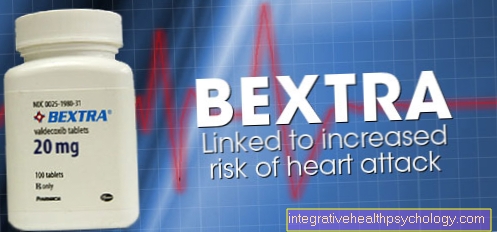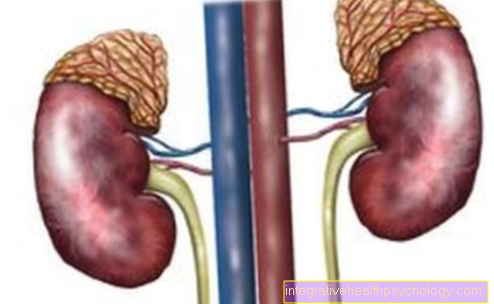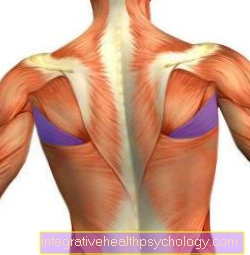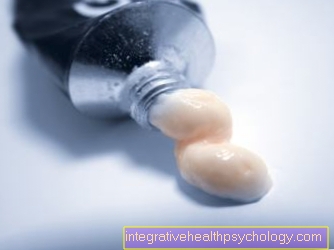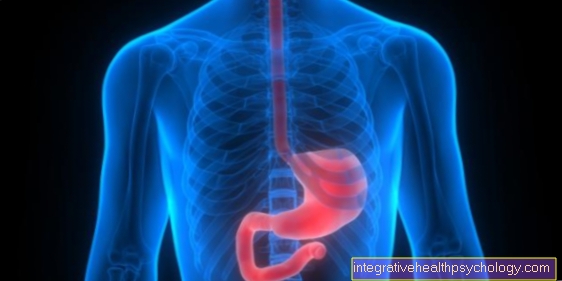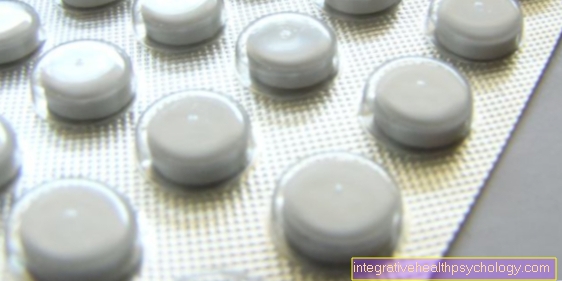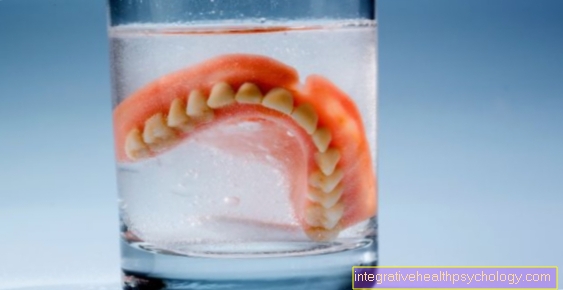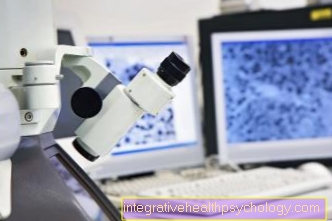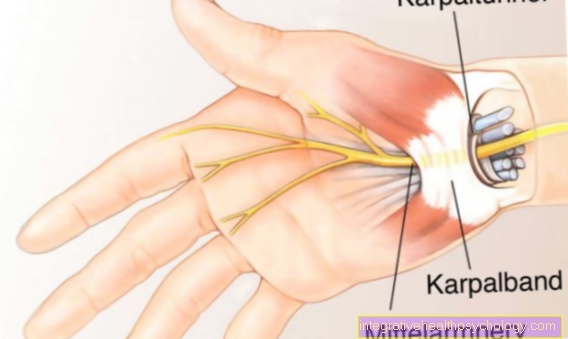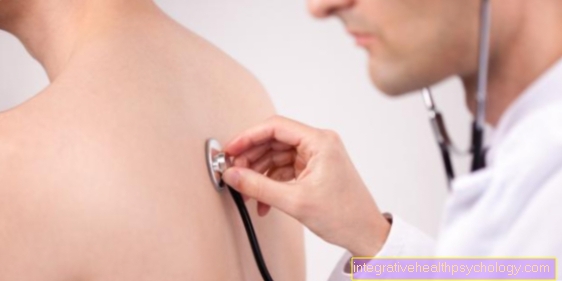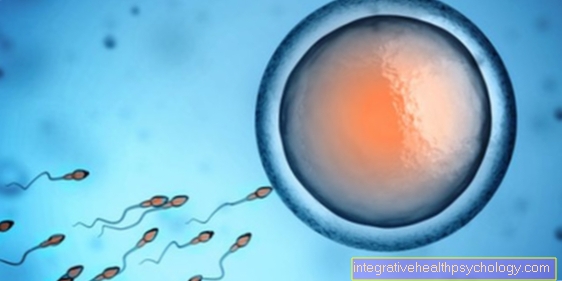Cellular respiration in humans
definition
Cell respiration, also called aerobic (from ancient Greek "aer" - air), describes the breakdown of nutrients such as glucose or fatty acids in humans using oxygen (O2) to generate energy, which is necessary for the survival of cells. The nutrients are oxidized, i.e. they give off electrons as oxygen is reduced, which means that it accepts electrons. The end products that arise from the oxygen and nutrients are carbon dioxide (CO2) and water (H2O).

Function and tasks of cellular respiration
All processes in the human body require energy. Exercise, brain function, the beating of the heart, saliva or hair making, and even digestion all require energy to function.
In addition, the body needs oxygen to survive. Cellular respiration is of particular importance here. With the help of this and the gas oxygen, it is possible for the body to burn energy-rich substances and to obtain the required energy from them. Oxygen itself does not provide us with any energy, but it is needed to carry out the chemical combustion processes in the body and is therefore essential for our survival.
The body knows many different types of energy carriers:
- Glucose (sugar) is the main energy source and basic building block as well as the end product split from all starchy foods
- Fatty acids and glycerine are the end products of the breakdown of fats and can also be used in energy production
- The last group of energy sources is the amino acids that are left over as a product of protein breakdown. After a certain transformation in the body, these can also be used in cell respiration and thus for energy generation
Read more about this under Exercise and fat burning
The most common energy source used by the human body is glucose. There is a chain of reactions that ultimately lead to the products CO2 and H2O with the consumption of oxygen. This process includes the Glycolysis, so the Splitting of glucose and the transfer of the product, the Pyruvate via the intermediate step of the Acetyl-CoA in the Citric acid cycle (Synonym: citric acid cycle or Krebs cycle). The breakdown products of other nutrients such as amino acids or fatty acids also flow into this cycle. The process in which the fatty acids are "broken down" so that they can also flow into the citric acid cycle is called Beta oxidation.
The citric acid cycle is therefore a kind of inlet point where all energy carriers can be fed into the energy metabolism. The cycle takes place in the Mitochondria instead, the “energy power plants” of human cells.
During all of these processes, some energy is consumed in the form of ATP, but it is already being obtained, as is the case, for example, in glycolysis. In addition, there are predominantly other intermediate energy stores (e.g. NADH, FADH2) that only fulfill their function as intermediate energy stores during energy generation. These intermediate storage molecules then flow into the last step of cell respiration, namely the step of oxidative phosphorylation, also known as the respiratory chain. This is the step towards which all processes have worked so far. The respiratory chain, which also takes place in the mitochondria, also consists of several steps in which the energy-rich intermediate storage molecules are then used to extract the all-purpose energy carrier ATP. In total, the breakdown of one glucose molecule results in a total of 32 ATP molecules.
For those particularly interested
The respiratory chain contains various protein complexes that play a very interesting role here. They function as pumps that pump protons (H + ions) into the cavity of the mitochondrial double membrane while consuming the intermediate storage molecules, so that there is a high concentration of protons there. This causes a concentration gradient between the intermembrane space and the mitochondrial matrix. With the help of this gradient, there is ultimately a protein molecule that works in a similar way to a type of water turbine. Driven by this gradient in protons, the protein synthesizes an ATP molecule from an ADP and a phosphate group.
You can find more information here: What is the respiratory chain?
ATP
The Adenosine triphosphate (ATP) is the energy carrier of the human body. All energy that arises from cellular respiration is initially stored in the form of ATP. The body can only use the energy if it is in the form of the ATP molecule.
If the energy of the ATP molecule is used up, adenosine diphosphate (ADP) is created from the ATP, whereby a phosphate group of the molecule is split off and energy is released. Cellular respiration or energy generation serves the purpose of continuously regenerating the ATP from the so-called ADP so that the body can use it again.
Reaction equation
Due to the fact that fatty acids are of different lengths and that amino acids also have very different structures, it is not possible to set up a simple equation for these two groups to precisely characterize their energy yield in cellular respiration. Because every structural change can determine in which step of the citrate cycle the amino acid flows.
The breakdown of fatty acids in the so-called beta oxidation depends on their length. The longer the fatty acids, the more energy can be gained from them. This varies between saturated and unsaturated fatty acids, with unsaturated ones providing minimally less energy, provided they have the same amount.
For the reasons already mentioned, an equation can best be described for the breakdown of glucose. This creates a total of 6 carbon dioxide molecules (CO2) and 6 water molecules (H2O) from a glucose molecule (C6H12O6) and 6 oxygen molecules (O2):
- C6H12O6 + 6 O2 become 6 CO2 + 6 H2O
What is glycolysis?
Glycolysis describes the breakdown of glucose, i.e. grape sugar. This metabolic pathway takes place in human cells as well as in others, e.g. in the case of yeast during fermentation. The place where cells perform glycolysis is in the cytoplasm. Here enzymes are present that accelerate the glycolysis reactions in order to both synthesize ATP directly and provide the substrates for the citric acid cycle. This process creates energy in the form of two molecules of ATP and two molecules of NADH + H +. Glycolysis, together with the citric acid cycle and the respiratory chain, both of which are located in the mitochondrion, represent the breakdown of the simple sugar glucose to the universal energy carrier ATP. Glycolysis takes place in the cytosol of all animal and plant cells.The end product of glycolysis is pyruvate, which can then be introduced into the citric acid cycle via an intermediate step.
In total, 2 ATP are used per glucose molecule in glycolysis in order to be able to carry out the reactions. However, 4 ATP are obtained so that there is effectively a net gain of 2 ATP molecules.
Glycolysis ten reaction steps until a sugar with 6 carbon atoms turns into two molecules of pyruvate, each made up of three carbon atoms. In the first four reaction steps, the sugar is converted into fructose-1,6-bisphosphate with the help of two phosphates and a rearrangement. This activated sugar is now split into two molecules with three carbon atoms each. Further rearrangements and the removal of the two phosphate groups ultimately result in two pyruvates. If oxygen (O2) is now available, the pyruvate can be further metabolized into acetyl-CoA and introduced into the citric acid cycle. Overall, glycolysis with 2 molecules of ATP and two molecules of NADH + H + has a relatively low energy yield. However, it lays the foundation for the further breakdown of sugar and is therefore essential for the production of ATP in cell respiration.
At this point it makes sense to separate aerobic and anaerobic glycolysis. Aerobic glycolysis leads to the pyruvate described above, which can then be used to generate energy.
The anaerobic glycolysis, on the other hand, which takes place under conditions of oxygen deficiency, the pyruvate can no longer be used, since the citric acid cycle requires oxygen. In the context of glycolysis, the intermediate storage molecule NADH is also created, which is energy-rich in itself and would also flow into the Krebs cycle under aerobic conditions. However, the parent molecule NAD + is necessary to maintain glycolysis. This is why the body “bites” the “sour apple” here and converts this high-energy molecule back into its original form. The pyruvate is used to carry out the reaction. The so-called lactate or lactic acid is formed from the pyruvate.
Read more about this under
- Lactate
- Anaerobic threshold
What is the respiratory chain?
The respiratory chain is the last part of the glucose breakdown path. After the sugar has been metabolized in the glycolysis and citric acid cycle, the respiratory chain has the function of regenerating the reduction equivalents (NADH + H + and FADH2) that are created. This creates the universal energy carrier ATP (adenosine triphosphate). Like the citric acid cycle, the respiratory chain is located in the mitochondria, which are therefore also referred to as the “power plants of the cell”. The respiratory chain consists of five enzyme complexes that are embedded in the inner mitochondrial membrane. The first two enzyme complexes each regenerate NADH + H + (or FADH2) to NAD + (or FAD). During the oxidation of NADH + H +, four protons are transported from the matrix space into the intermembrane space. Two protons are also pumped into the intermembrane space for the following three enzyme complexes. This creates a concentration gradient that is used to produce ATP. For this purpose, protons flow from the intermembrane space through an ATP synthase back into the matrix space. The energy released is used to finally produce ATP from ADP (adenosine diphosphate) and phosphate. Another task of the respiratory chain is to intercept the electrons generated by the oxidation of the reduction equivalents. This is done by transferring the electrons to oxygen. By bringing together electrons, protons and oxygen, normal water is created in the fourth enzyme complex (cytochrome c oxidase). This also explains why the respiratory chain can only take place when there is enough oxygen.
What tasks do the mitochondria have in cell respiration?
The mitochondria are organelles that are only found in eukaryotic cells. They are also referred to as the “power plants of the cell”, as it is in them that cell respiration takes place. The end product of cellular respiration is ATP (adenosine triphosphate). This is a universal energy carrier that is required in the whole human organism. The compartments of the mitochondria are a prerequisite for cell respiration. This means that there are separate reaction spaces in the mitochondrion. This is achieved by an inner and an outer membrane so that there is an intermembrane space and an inner matrix space.
In the course of the respiratory chain, protons (hydrogen ions, H +) are transported into the intermembrane space, so that a difference in concentration of protons arises. These protons come from various reduction equivalents, such as NADH + H + and FADH2, which are thereby regenerated to NAD + and FAD.
ATP synthase is the last enzyme in the respiratory chain, where ATP is ultimately produced. Driven by the difference in concentration, the protons flow from the intermembrane space through the ATP synthase into the matrix space. This flow of positive charge releases energy that is used to produce ATP from ADP (adenosine diphosphate) and phosphate. The mitochondria are particularly suitable for the respiratory chain, as they have two reaction spaces due to the double membrane. In addition, many metabolic pathways (glycolysis, citric acid cycle), which provide the starting materials (NADH + H +, FADH2) for the respiratory chain, take place in the mitochondrion. This spatial proximity is another advantage and makes the mitochondria the ideal place for cell respiration.
Here you can find out everything about the topic of the respiratory chain
Energy balance
The energy balance of cell respiration in the case of glucose can be summarized as follows, with the formation of 32 ATP molecules per glucose:
C6H12O6 + 6 O2 become 6 CO2 + 6 H2O + 32 ATP
(For the sake of clarity, the ADP and the phosphate residue Pi have been omitted from the educts)
Under anaerobic conditions, i.e. lack of oxygen, the citric acid cycle cannot run and energy can only be obtained through aerobic glycolysis:
C6H12O6 + 2 Pi + 2 ADP become 2 Lactate + 2 ATP. + 2 H2O. So only about 6% of the proportion is obtained per glucose molecule, as would be the case with aerobic glycolysis.
Diseases related to cellular respiration
The Cellular respiration is essential for survivali.e. that many mutations in the genes responsible for the proteins of cell respiration, e.g. Enzymes of glycolysis, coding, lethal (fatal) are. However, genetic diseases of cell respiration do occur. These can originate from nuclear DNA or from mitochondrial DNA. The mitochondria themselves contain their own genetic material, which is necessary for cell respiration. However, these diseases show similar symptoms, since they all have one thing in common: they intervene in cellular respiration and disrupt it.
Cellular respiratory diseases often show similar clinical symptoms. It is especially important here Disorders of tissues, which need a lot of energy. These particularly include the nerve, muscle, heart, kidney and liver cells. Symptoms such as muscle weakness or signs of brain damage often occur even at a young age, if not at the time of birth. Also speaks a pronounced Lactic acidosis (An over-acidification of the body with lactate, which accumulates because the pyruvate cannot be sufficiently broken down in the citric acid cycle). Internal organs can also malfunction.
The diagnosis and therapy of diseases of cellular respiration should be carried out by specialists, since the clinical picture can be very diverse and different. As of today it is still no causal and curative therapy gives. The diseases can only be treated symptomatically.
Since the mitochondrial DNA is passed on from mother to children in a very complicated way, women who suffer from a disease of the cellular respiration should consult a specialist if they want to have children, as only they can estimate the probability of inheritance.



